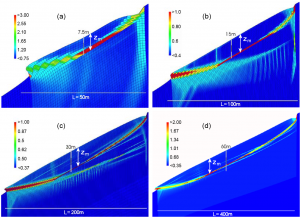Meeting:Abstract 2011 CSDMS meeting-066
Browse abstracts
Landslide rupture and length-depth scaling
[[Image:|300px|right|link=File:]]Landslides are often assumed to exhibit self-similarity in their failure geometry, and thus a linear scaling between slip depth and rupture length. This assumption has important implications for the prediction of large landslide volumes and for the estimation of erosion budgets by mass-wasting. Nevertheless, some field data indicate a break from self-similarity and imply that, in some circumstances, landslide depth may scale non-linearly with length. Here we test the simple scaling hypothesis by numerical experiment. Modeling is performed with SNAC (StGermaiN Analysis of Continua), a 3D community code originally designed to model viscoelastoplastic deformation on a crustal scale and newly adapted to treating hillslope failure. SNAC employs a parallelized, Lagrangian, explicit finite-difference scheme and dynamic relaxation to solve static, quasi-static and steady-state problems. Landslide rupture is treated as emergent shear localization under strain-weakening Mohr-Coulomb plasticity. We model only the initial slip and early motion of a landslide; granular flow during the runout phase is not considered. A set of 2+1D simulations of failures spanning lengths of 50–400m suffice to vindicate cross-sectional self-similarity—absent any dominant depth scale or trend in the variation of cohesion—and a depth-length ratio of 11–15% is recorded. An interesting by-product of the choice of experimental geometry is some unanticipated complexity in the evolution of the slip plane. Failure initiates at the toe, propagates upslope, and asymptotically parallels the planar upper boundary. However, a connected failure surface is only achieved once a secondary rupture has propagated downwards into this slip plane from the upper breakaway zone. The broader outcome of our numerical experiments is a demonstration of how 3D continuum modeling of soil and rock-slope failure, and the study of their rich behavior, is now feasible using non-commercial code on supercomputing platforms.

